Digital network cameras are increasingly coming into play for surveillance and security applications.
Fading fast are the days of closed-circuit television, yesterday’s video surveillance staple that displays the output of analog cameras on monitors. It can be an inexpensive solution. However, the image can be grainy, the hours spent recording video a hassle, and the multicamera installation management difficult and costly.
Today, the trend is toward network cameras, which are Internet protocol (IP)-based and digital. They offer megapixel and high-definition resolution, helping tasks ranging from security to determining which displays attract people in a store. They also are increasingly intelligent, able to extract and transmit only what is important in a scene. As a result, they can do double or triple duty.
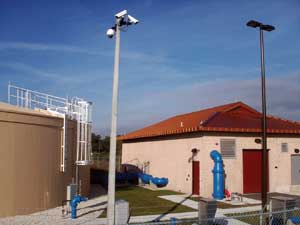
Thanks to their image quality, network cameras can do more than security. St. Cloud, Fla., uses cameras to watch the perimeter of the city’s water treatment facility, with high-definition video and alarms monitoring tanks and gauges. Courtesy of Axis Communications.
“In traffic monitoring, you can use them to just get warnings and traffic information, but they can also be used if someone is breaking the rules,” said Jonas Andersson, director of business development at Axis Communications, a Lund, Sweden-based pioneer of network video cameras.
Not unlike the cameras, Andersson has more than one job. He also chairs the steering committee for the industry forum ONVIF, which is standardizing IP surveillance interfaces, thereby opening up the market. Another trade group, the Physical Security Interoperability Alliance, seeks something similar, although using a different approach.
As with the latter, ONVIF has released a core specification that covers video storage devices, video analytics engines, cameras and encoders. Thus, if a camera and a server are both stamped as satisfying the ONVIF streaming video profile, the two can communicate with each other, no matter the manufacturer. To help ensure this, ONVIF has created tools to test device conformance, Andersson said.
Growing capabilities
As for the future, the group is looking to expand its reach. For example, it is considering incorporating into its specs other aspects of security, such as building access control. It has already tackled such things as camera control.
“We have the possibility to look at exposure and so on,” Andersson said. “It is an optional feature that can handle iris, shutter time and so on.”
Putting on his Axis Communications hat, he noted that network cameras can do more than simply capture video. For instance, they can recognize when a car has pulled up, image its license plate and transmit only that or extracted identifiers. This is possible because the cameras have spare processing capacity that can be used for intelligent features and to power third-party applications hosted by the device itself, Andersson said.
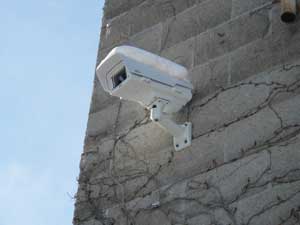
Network surveillance cameras operate in all conditions and over temperatures ranging from —40 to 167 °F. Here a snow-covered camera keeps watch on a Canadian car dealership. Courtesy of Axis Communications.
NPD In-Stat, a Scottsdale, Ariz.-based market analysis firm, predicts that the image sensors and other chips found in video surveillance gear will approach $3.5 billion in revenue by 2015. Semiconductors then will make up about 21 percent of the total surveillance market revenue.
When it comes to the sensor at the heart of the cameras, there is a clear favorite, said Max Baron, an NPD In-Stat analyst. “Since we’re talking video, CMOS is gaining market share.”
CMOS dominance is particularly evident in faster and more expensive cameras that offer higher resolution and higher performance. Sergio Collazo is director of sales and marketing for Irvine, Calif.-based Toshiba Surveillance & IP Video Products. The company’s offerings range from analog to the latest network cameras. Many of Toshiba’s megapixel surveillance cameras use CMOS – not CCD – sensors.
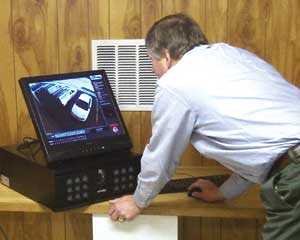
Because they are connected, IP cameras can output images to anywhere on a network. Here, multimode fiber optic cable transmits video signals from cameras to a 32-channel network video recorder 600 ft away. This allows remote viewing of payment, truck traffic and the weighing of recycled materials. Courtesy of Toshiba American Information Systems.
CMOS sensors take up less space, consume less power and are cheaper than the alternative, Collazo said. He added that, with the use of infrared, LEDs and day/night imaging, CMOS-based cameras perform as well in poor light conditions as CCD-based ones, even in situations of near complete darkness.
Collazo noted that worldwide sales of network cameras are more than $1 billion, and he expects that to grow fourfold by 2015. Analog camera sales, in contrast, are flat or falling. By 2014 or so, the sales of the two will cross, although analog cameras will still make up the majority of unit sales.
As for general trends, he pointed to the emergence of high-definition video, megapixel cameras and the adoption of the H.264 compression standard as all benefiting IP cameras. He also said that network cameras can reduce overall installation costs, particularly because current infrastructure often can be used. Little or no, or new, wiring may be needed, either for data or power.
“Onboard PoE (Power over Ethernet) now allows a single Ethernet cable to transfer both data and power to and from an IP camera,” Collazo said.
He predicted that video analytics will gain traction in the future. Substituting software for security personnel automates such tasks as counting the number of people entering or exiting a building, detecting unattended objects or spotting someone entering a restricted area. Once a problem is uncovered, an alarm can be sent by email, voice, text or another means.
Video analytics should indeed drive sales of future surveillance cameras and systems, said John Devlin, London-based group director for the security and identification practice at consultancy ABI Research. The company foresees a more than 10 percent growth rate year over year for the next half-decade for video analytics. Security accounts for 70 percent of surveillance system expenditures today; Devlin expects it to fall to 60 percent by 2016, thanks to the rising use of video analysis in business intelligence and other applications.
He sees the shift to edge devices to do the analysis as part of the evolution of cameras. One aspect of this is that more network cameras are being installed. Another is that those cameras already have or soon will pack the necessary processing power. And if semiconductor trends hold, cameras will be capable of performing even more sophisticated analysis in the future.
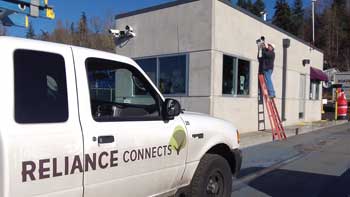
Cameras being installed at RS Davis Recycling in Clackamas, Ore. Courtesy of Toshiba American Information Systems.
The edge analytics impact will be largely on the system as a whole, Devlin said. For instance, if a video feed is extensively analyzed, then perhaps only a small amount of data will actually have to travel over the network. That will reduce data volumes being transmitted, a challenge facing video surveillance, and what data there is can be distributed over many devices.
Cloud-based analytics have been touted as one possible countervailing trend. In a way, this is a back-to-the-future case, as all video analysis used to be done remotely. In practice, there are problems with actually carrying out cloud-based analytics. There are privacy concerns and uncertainty about who owns the video.
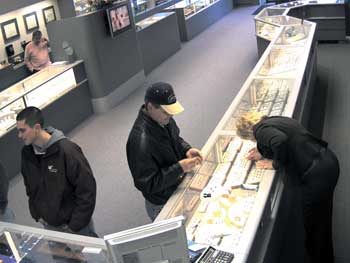
Megapixel images helped a jewelry store first confirm a theft and then identify the perpetrator, who had palmed a $40,000 ring and walked out. Courtesy of IQinVision.
Overrun with pixels
There also are issues in dealing with the large amount of data generated. For one thing, it demands an always-on and always-present high-bandwidth connection, which can be a problem.
“The required level of redundancy is not possible at the level of bandwidth required for the transmission of a high-capacity video feed,” Devlin said.
Handling the output that high-resolution cameras can produce is a general industry concern. Don Ashley, product manager of network camera maker IQinVision of San Juan Capistrano, Calif., noted that it’s possible to put a 20-megapixel camera in a surveillance system. However, it then can become a burden to store, transmit, decode, view and analyze the data. Larger sensors also can mean heavier optics, necessitating heftier pan, tilt and zoom motors, if these are present. The entire assembly then may need a beefed-up mounting bracket and a sturdier pole.
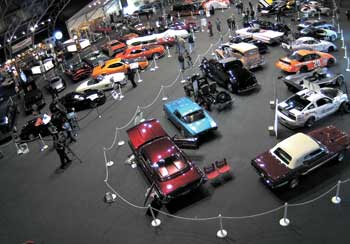
Network cameras monitor a luxury car auction and record any events in or around the vehicles. Courtesy of IQinVision.
Clearly, it’s important to have the right resolution for a particular situation. There has to be enough detail to reveal whatever is of interest, but anything beyond that may be a megapixel too far.
As for analytics done on the edge and perhaps in the camera itself, that, too, requires striking a balance. Intelligent analysis can, for example, make large megapixel sensor deployments more efficient by identifying motion and sending only images or areas with movement to a recording solution.
However, there will be some level of false-positives, times when an alarm is tripped but nothing is actually amiss. That figure can run as much as 25 percent, Ashley said; that is, perhaps one out of four times, motion will be detected when nothing actually moves, other than perhaps a shadow.
Even given these realities, however, video surveillance and the cameras that produce it can still be critically important. The video can help companies catch thieves or identify why a retail sales campaign is successful. That makes the camera more valuable than it first appears.
How do companies view these devices?
“It’s not just a camera,” Ashley said. “It’s the camera that creates video that they view as an asset.”